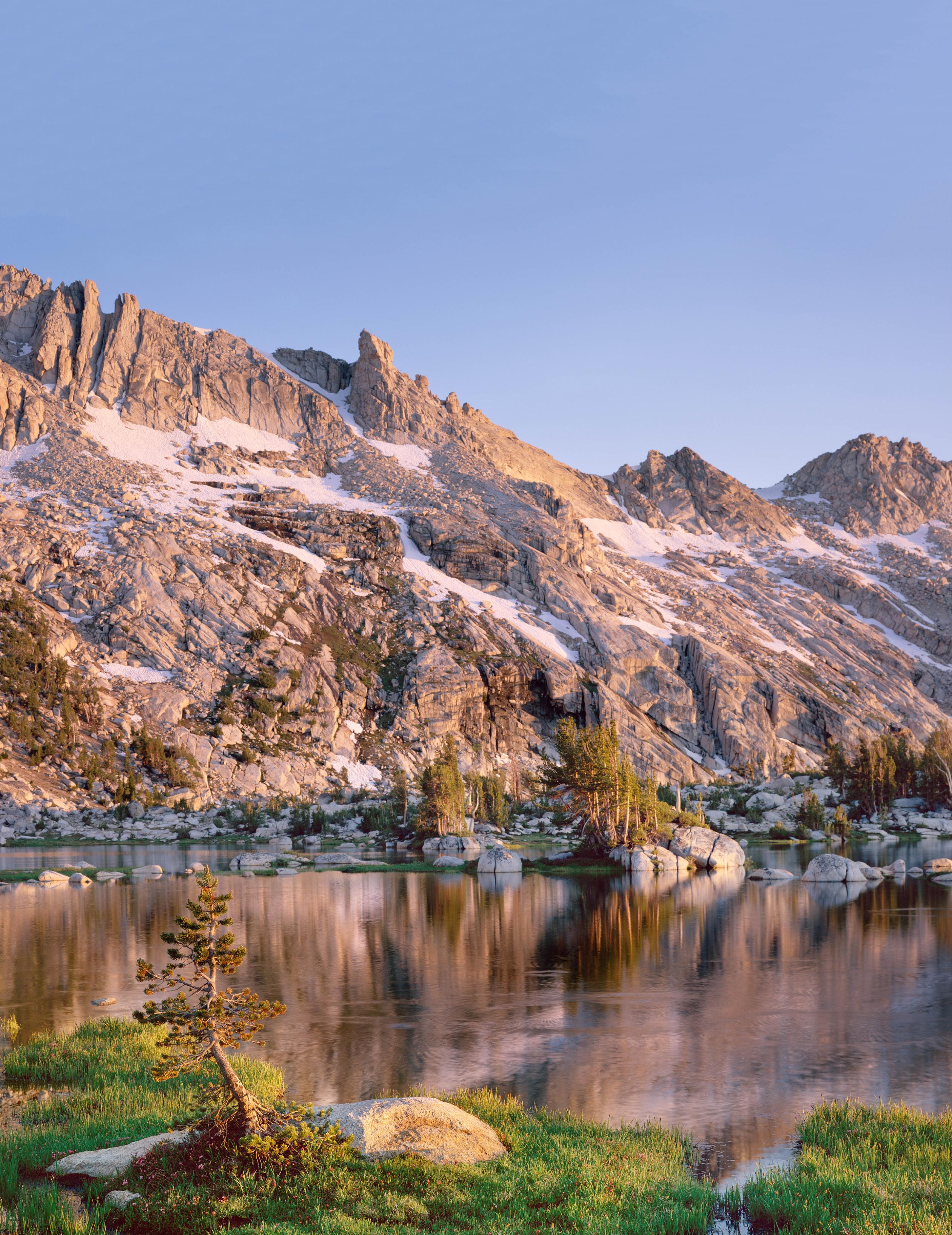

YOSEMITE CONSERVANCY
OUR MISSION
Yosemite Conservancy inspires people to support projects and programs that preserve Yosemite and enrich the visitor experience for all people.
PRESIDENT’S NOTE
YOSEMITE CONSERVANCY COUNCIL MEMBERS
CHAIR
Matt Adams*
VICE CHAIR
Dana Dornsife* SECRETARY/ TREASURER
COUNCIL
Hollis & Matt Adams *
Jeanne & Michael Adams
Gretchen Augustyn
Jenny Augustyn & Ali Meghdadi
Bob* & Suzy Bennitt
Kira & Craig Cooper
Hal Cranston & Vicki Baker
Carol & Manny Diaz
Diane* & Steve Ciesinski*
Dana* & Dave Dornsife*
Leslie & John Dorman*
Jewell* & Bob Engstrom
Sandra & Bernard Fischbach
Kathy Fairbanks
Cynthia & Bill Floyd
Don* & Susan Fuhrer
Bonnie Gregory
Rusty Gregory*
Karen & Steve Hanson
Laura Hattendorf & Andy Kau
Christy & Chuck Holloway
Christina Hurn
Mitsu Iwasaki
Jim Freedman& Karine Joret
Erin & Jeffrey Lager
Steve Ciesinski*
PRESIDENT & CEO
Frank Dean*

Bob & Melody Lind
Steve Lockhart & Karen Bals
Patsy & Tim Marshall
Kirsten & Dan Miks
Robyn* & Joe Miller
Zenaida Aguirre-Muñoz & Juan Sánchez Muñoz
Sharon & Phil* Pillsbury
Kate & Ryan* Myers
Dick Otter & Judy Wilbur
Gisele & Lawson* Rankin
Bill Reller
Pam & Rod Rempt
Skip Rhodes
Stephanie & Mark Robinson
Blerina Aliaj & Alain Rodriguez
Dave Rossetti* & Jan Avent*
Greg* & Lisa Stanger
Ann* & George Sundby
Alexis & Assad Waathiq
Jack Walston & Sue Estes
Clifford J. Walker *
Wally Wallner* & Jill Appenzeller
Helen & Scott Witter
YOSEMITE NATIONAL PARK
Superintendent Cicely Muldoon
*Indicates Board of Trustees
s is the case for many organizations — and individuals — Yosemite Conservancy’s resilience and ability to adapt have been tested in the past 12 months. We're grateful to have weathered the year relatively well, thanks to our team's flexibility and dedication, strong relationships with the National Park Service and other partners, and generous support from you, our Conservancy community.
In this issue of our semi-annual magazine, you’ll meet Conservancy team members who have adjusted to new roles and conditions in order to keep park fans engaged and safe, and step inside the world of “Ranger Couches” and “Learning Labs” to see how Yosemite educators have been working to inspire the next generation of park champions from afar.
As we reflect on how the Conservancy and our NPS partners navigated the past year, we’re also considering the ways in which adaptability and resilience play out for our fellow living beings, and determining how plants and animals fare over time. It’s hard not to marvel at the adaptations of species that make their homes in the park, from color-changing weasels to chlorophyll-free snow plants, to organisms that survive cold winters with sparse food and hot summers with minimal water. And the ways in which species prove adaptable and resilient — or not — in the face of rising temperatures, less snow and other shifts related to climate change can remind us of the marks we leave on ecosystems even when we’re far from a meadow or forest.
Human influence on the natural environment is significant, but thanks to our supporters, there is good news to share, too, especially about efforts to improve the resilience of Yosemite’s plant and animal communities. Within the past two decades, donor-funded grants have enabled the NPS to document a Sierra Nevada red fox south of Tioga Pass for the first time in over a century, and to reintroduce Sierra Nevada bighorn sheep, California red-legged frogs and peregrine falcons to the park. Restoration projects have healed fragmented habitat from Wawona to Yosemite Valley to Lyell Canyon, and they will soon revitalize Ackerson Meadow, which our donors helped purchase and donate to the park in 2016. This kind of work can take years, as project leaders adapt their approaches and forge ahead through setbacks toward a vision of a vibrant wetland or a self-sustaining species. The resilience of the researchers and crews, and of the donors who support their work, is no small thing.
This past year has been arduous for everyone. We appreciate all you have endured and that you remain steadfast Yosemite champions. You continue to make Yosemite a better place!
With gratitude, Frank Dean, President
researchers, restoration crews and educators. Your support is essential to ensuring the park continues to thrive and inspire.
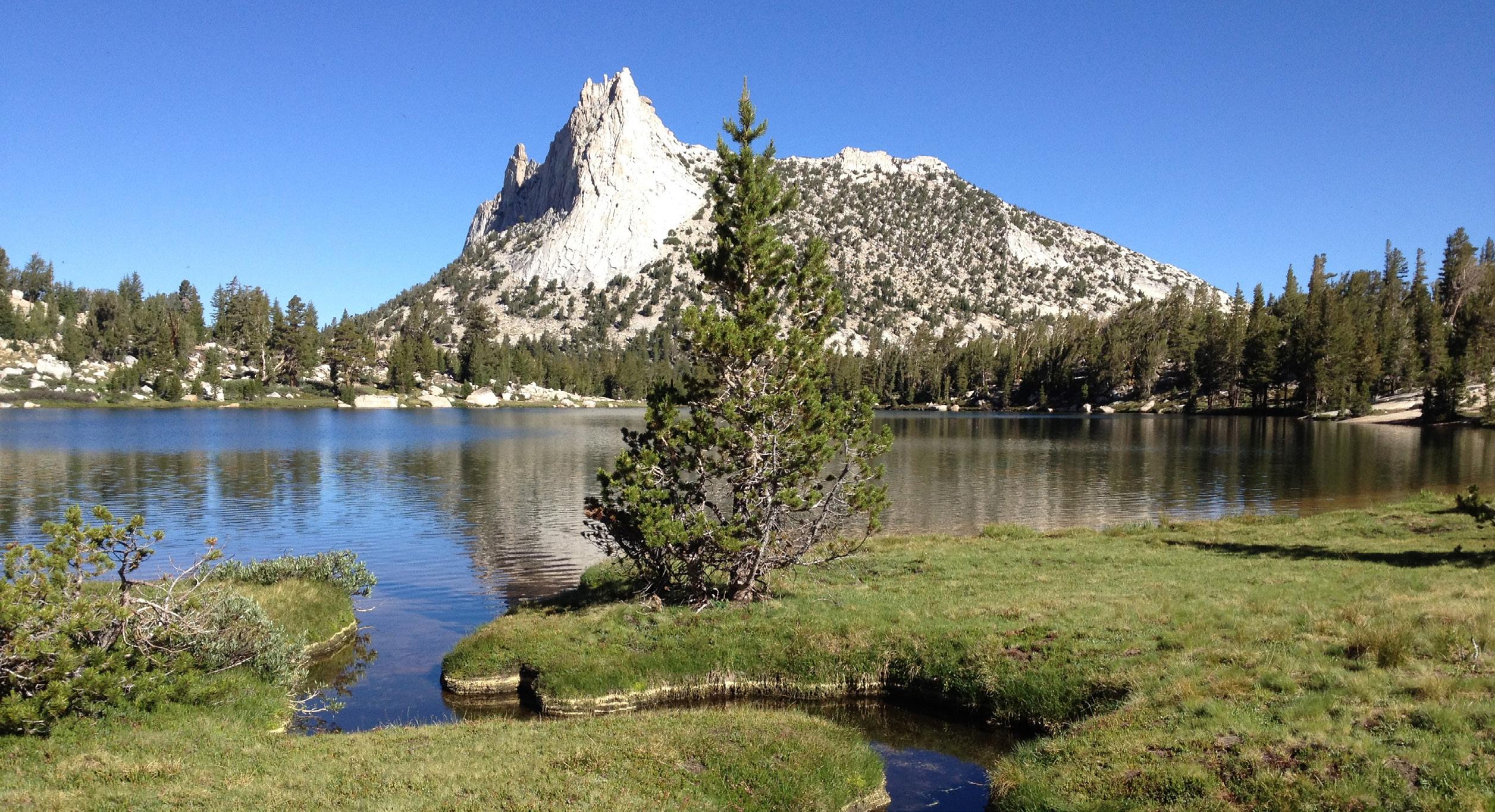

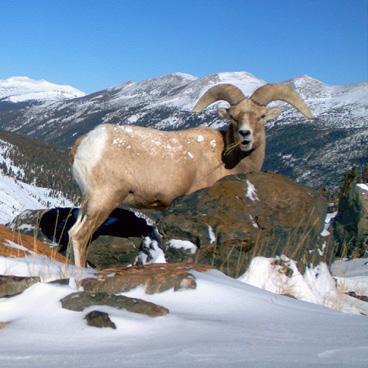

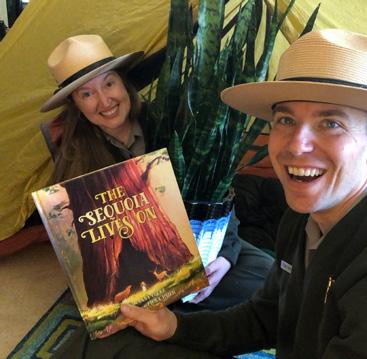
04 LIFE, CHANGING
How plants and animals adapt to life in the Sierra Nevada.

08 RESEARCHING RESILIENCE
Why saving a species takes dedicated researchers — and steadfast support.
12 TUOLUMNE MEADOWS: SNAPSHOTS IN TIME
A glimpse at the history of a celebrated part of Yosemite’s high country.
16 STAYING CURIOUS, FROM A DISTANCE
How park-based educational programs have adjusted and innovated during the pandemic.
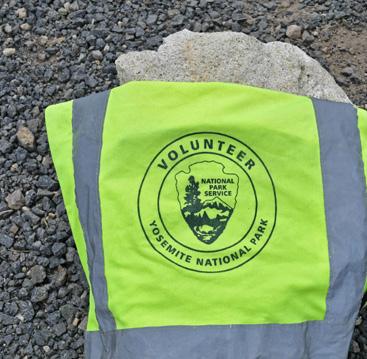

20 CELEBRATING 50 YEARS OF LEARNING IN YOSEMITE
Naturalist Pete Devine offers insights on a milestone year for Outdoor Adventures.
24 GETTING BACK TO GIVING BACK
Our volunteer program leader shares reflections from the past year.
27 MEET THE TEAM: NICOLE BROCCHINI
Q&A with the Yosemite Museum Store manager.
28 THROUGH YOUR LENS
Park fans share their photos of Yosemite.
29 STAY IN TOUCH
Contact information and ways to get involved.


Life,
CHANGING
xtremes abound in Yosemite: enormous waterfalls, impossibly tall trees, millions of visitors. Seasonal shifts sweep in surging snowmelt, parched summers and sky-choking wildfires.
This land of sometimes-harsh superlatives is also known for its extraordinary biodiversity. Life in Yosemite cheeps from boulders, filters water, dives in icy streams, and follows fire into a world of rich soil and sunlight.
PHOTO A Clark’s nutcracker in Yosemite’s high country.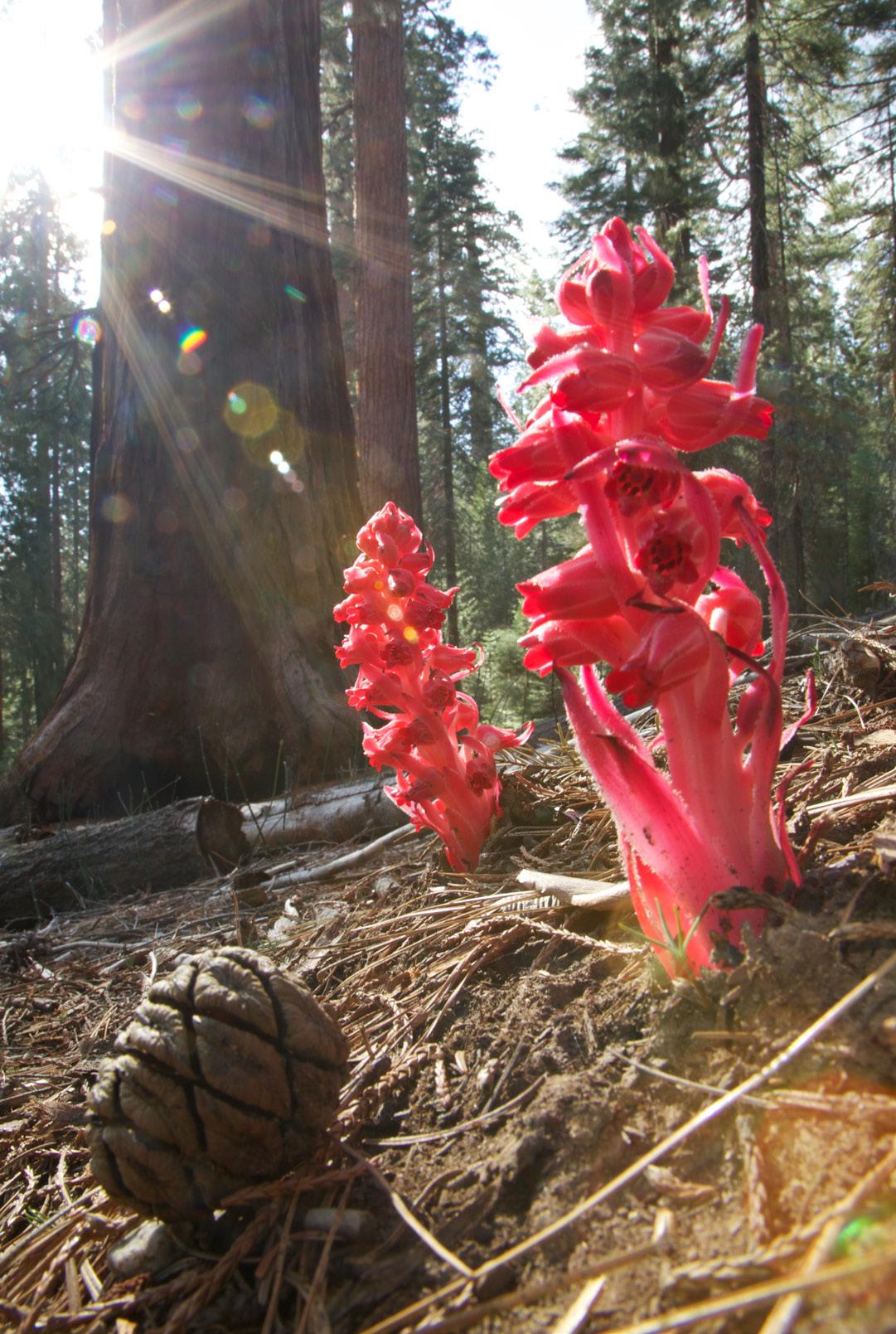


Many of Yosemite’s plants and animals seem well adapted to their Sierra Nevada setting. In biological terms, adaptation is often tied to natural selection: Traits that promote reproductive success are selected over time. Take the Yosemite pseudoscorpion (Parobisium yosemite), first identified via Conservancy–funded research in the early 2010s. Biologists think the species, which was found in debris from an avalanche near Mirror Lake, adapted from life on the surface to become a successful troglodyte, or cave-dweller, within several thousand years — a blink of an eye, in evolutionary terms.
Adaptation via natural selection can be hard to pin down. But evolutionarily adapted or not, many organisms have fascinating ways of surviving, even flourishing, in Yosemite.
At the park’s soaring heights, you’ll find plants and animals with characteristics that support survival in tough environs. That’s the case for two mammalian subjects of Conservancy-funded research projects: Snowshoe-like paws help the Sierra Nevada red fox float across winter terrain; bighorn sheep rely on phenomenal agility and sticky hooves to navigate steep peaks and narrow ledges. Another alpine denizen, the Clark’s nutcracker, has a special survival trick: Hippocampal plasticity allows the bird’s brain to swell temporarily to remember the locations of thousands of winter food caches of whitebark pine seeds.
Hardy plants dwell at Yosemite’s highest elevations, too. On Mt. Dana (13,000'), Conservancy-funded research has documented alpine spiny rattleweed, fellfield daisies and other vegetation anchored on rocky slopes unscoured by glaciers. To survive above tree line, these low-growing plants make the most of minimal soil and a brief summer season.
Examples of adaptation in Yosemite aren’t limited to the high peaks. In the Valley, you might spot brown short-tailed weasels with built-in snow camo — fur that turns white in winter; desiccated moss waiting out hot summers but ready to spring to life in rainstorms; and webtoed salamanders suited to life on slick rocks in waterfall spray zones.
In sequoia groves, tiny seeds poised to become 200-foot-tall giants rest inside thumb-length cones, waiting to be released by beetles, squirrels or fire. As donor-funded research has documented, a variety of other
TOP From towering trees that use wide, shallow root systems to soak up snowmelt, to fire-adapted cones, to snow plants that take advantage of plentiful subsoil fungi, sequoia groves offer ample examples of adaptation in action. (They also show how rapid climate shifts are upending some organisms’ resilience: After recent sequoia fatalities, Conservancy-funded research is investigating how drought and hotter, more intense fires are affecting the sequoias’ survival.)
MIDDLE Pikas aren’t just cute furballs; they’re experts at alpine survival. These rabbit relatives gather, dry and store plants to get through long winters, and Conservancy-funded research suggests their ability to find “microclimates” could make them more resilient than anticipated as temperatures rise. BOTTOM Sky pilots live at Yosemite’s highest elevations. Their sturdy, hairy stems nestle in rocky crevices, and they emit a pungent odor to attract pollinators, an extra lure to their short-lived, purple-blue flowers, each of which is in full bloom for just one day.

Yosemite plants are adapted to fire-fueled reproduction; flames, heat and smoke can jumpstart germination, rejuvenate soil and create space for light to reach seedlings.
Many organisms have remarkable features and behaviors that help them thrive in Yosemite. But with human-driven climate change already transforming conditions in the Sierra Nevada, how will life adapt?
National Oceanic and Atmospheric Administration data show temperatures in Yosemite going back to 1905; 11 of the 15 highest recorded annual averages have occurred since 2000. When temperatures change, so do life zones. Conservancy-supported studies in the early 2000s found that 17 species of small mammals had moved to higher elevations in the past century.
Other research shows that the lower edge of the Sierra Nevada’s ponderosa pine tree line has moved upslope in the past century, retreating from rising temperatures and opening space for hardwoods and chaparral. As pines shift upward, their seeds take root in subalpine meadows, transforming ecosystems on which wetland-dwelling plants and animals depend.
While shifting ranges could affect many species, Conservancy-funded research has shown that some Yosemite organisms might be more resilient than anticipated — for now. Pikas, small rabbit relatives found in high-elevation talus fields, rely on their dense fur and stashes of dried
plants to survive long winters. Scientists thought rising temperatures would push pikas higher and higher until they ran out of livable space. Conservancy-funded research in the 2010s, however, showed that Yosemite’s pikas might be more tolerant to climate change than predicted, thanks in part to “microclimates” in their rocky habitats that offer cooler zones and ample vegetation.
In the avian world, data from decades of donor-supported research suggests that some birds found in the Sierra Nevada benefit from warmer, earlier springs, with some species, such as dusky flycatchers, breeding sooner and more successfully as snowfall decreases and temperatures rise.
Those results come with a caveat: It’s unclear how pikas, birds and other Yosemite species will adapt as the effects of climate change escalate, not just in rising temperatures, but also in more extreme storms, droughts and wildfires.
Yosemite’s animals and plants offer plenty of inspiration for adapting within an intricate, often enigmatic, and rapidly changing web of life, landscapes and processes. Learning about fellow species, from their admirable adaptations to the threats they face, can help us better recognize that we are part of that web, and that our actions affect life and land far beyond screens, streets and state lines. Thanks to Conservancy donors, researchers are expanding our knowledge of plant and animal life in Yosemite, and creating opportunities for learning, appreciation and action.
Resilience RESEARCHING

he Sierra Nevada yellow-legged frog and the Sierra Nevada bighorn sheep may not seem especially alike, other than being named for their mountainous home.
One lives in Yosemite’s high country lakes; the other dwells in the craggy precipices of the Cathedral Range. What unites these species is their resilience in a harsh landscape where they have come back from the brink of extinction.
Both species are federally recognized as endangered. With support from Yosemite Conservancy donors, research teams specializing in aquatic and terrestrial wildlife have been studying the frogs and sheep for decades, monitoring each species’ decline, and working to rebuild their populations.
ABOVE Sierra Nevada yellow-legged frogs, once abundant in Yosemite, vanished from the park for decades. Thanks to enduring support from donors, the species is rebounding in the park. RIGHT A group of researchers search for signs of sheep near Virginia Lakes, just outside Yosemite’s eastern boundary. Thanks to funding from generous donors, including the Arthur L. & Elaine V. Johnson Foundation, scientists have been able to delve into the long-term work of monitoring and expanding herds of endangered bighorn sheep in the Yosemite area.



IN THE EARLY 1900 s , Yosemite’s yellow-legged frog population was so abundant that journals reported waves of the amphibians leaping out of the park’s highelevation lakes and ponds. Eighty years later, surveys revealed the species had vanished from 90% of Yosemite’s lakes. Researchers attributed the decline to non-native fish and a virulent fungal disease.
Roland Knapp, a research biologist at the Marine Science Institute at the University of California, Santa Barbara, has studied Yosemite’s yellow-legged frogs since the mid-1990s. Pouring energy into an amphibian population in such dire straits “requires a certain mindset to look at the remaining population and focus on the small percentage who were still there and surviving,” Knapp says.
Early on, the research goal was to map every watershed in the Sierra Nevada and look for evidence of yellow-legged frogs, Knapp says. That’s more than 8,000 lakes and ponds, a daunting task for even the most stubborn scientists.
“We went to every site,” Knapp says. “It was 15 people over five years driven mostly by hope. Maybe every hundred lakes, you’d find a frog population.”
It became clear that saving the frogs meant removing nonnative trout. Creating trout-free lakes protected the frogs from predation, but it turned out fish weren’t the only threat.
“Resilience is moving forward to return an ecosystem to what it was. We have to learn from it and grow.”
— SALLY MODE
Senior Trustee of the The Arthur L. & Elaine V. Johnson Foundation
Knapp and his team found another killer in the frogs’ midst: chytrid fungus (Batrachochytrium dendrobatidis).
After years of work and close coordination with Yosemite’s aquatic biologist, Rob Grasso, yellow-legged frogs are once again splashing and sunning in the high country — but that’s not the end of the story. Knapp, Grasso and others are still pursuing their quest to ensure the species can grow and flourish, including by studying chytridresistance, rearing new yellow-legged frog generations at the San Francisco Zoo, and relocating frogs to healthy lakes. This work is supported by the Dorrance Family Foundation, which is thinking about amphibians in the long term: “We hope to collaborate with other agencies and bring in other funders who can help with the efforts to conserve these species and ecosystems.”
Sierra Nevada bighorn sheep epitomize endurance, making their homes in rugged, steep alpine terrain. But they’re not invincible. In the 1800s, herders and homesteaders brought domestic sheep to the Sierra Nevada, introducing ovine diseases to which bighorns had no immunity. By 1995, only 100 bighorns remained in their namesake range.
In recent decades, Conservancy donors have played an essential role in efforts to grow the bighorn population in and around Yosemite, including to reintroduce wild sheep along the park’s eastern boundary and in the Cathedral Range.
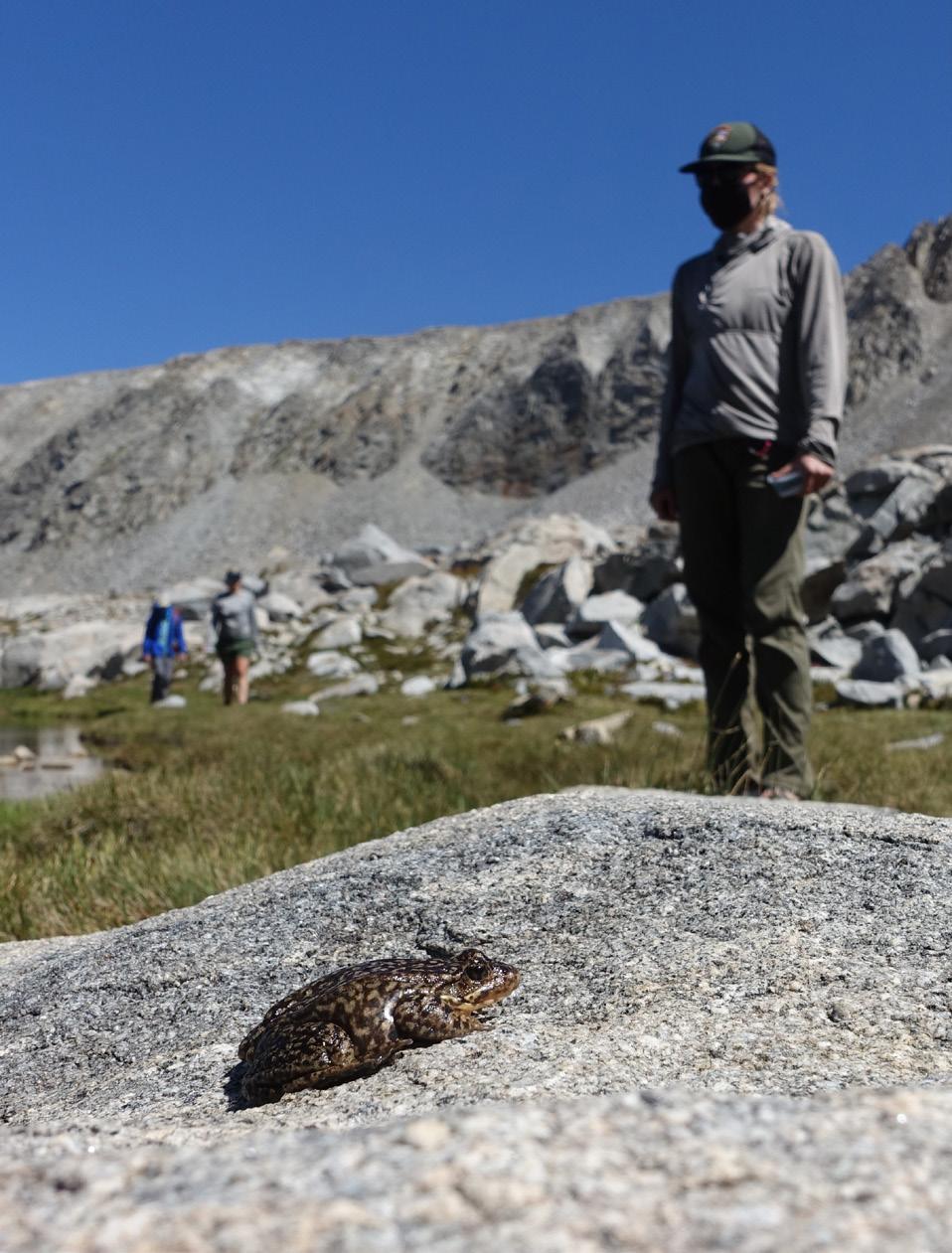
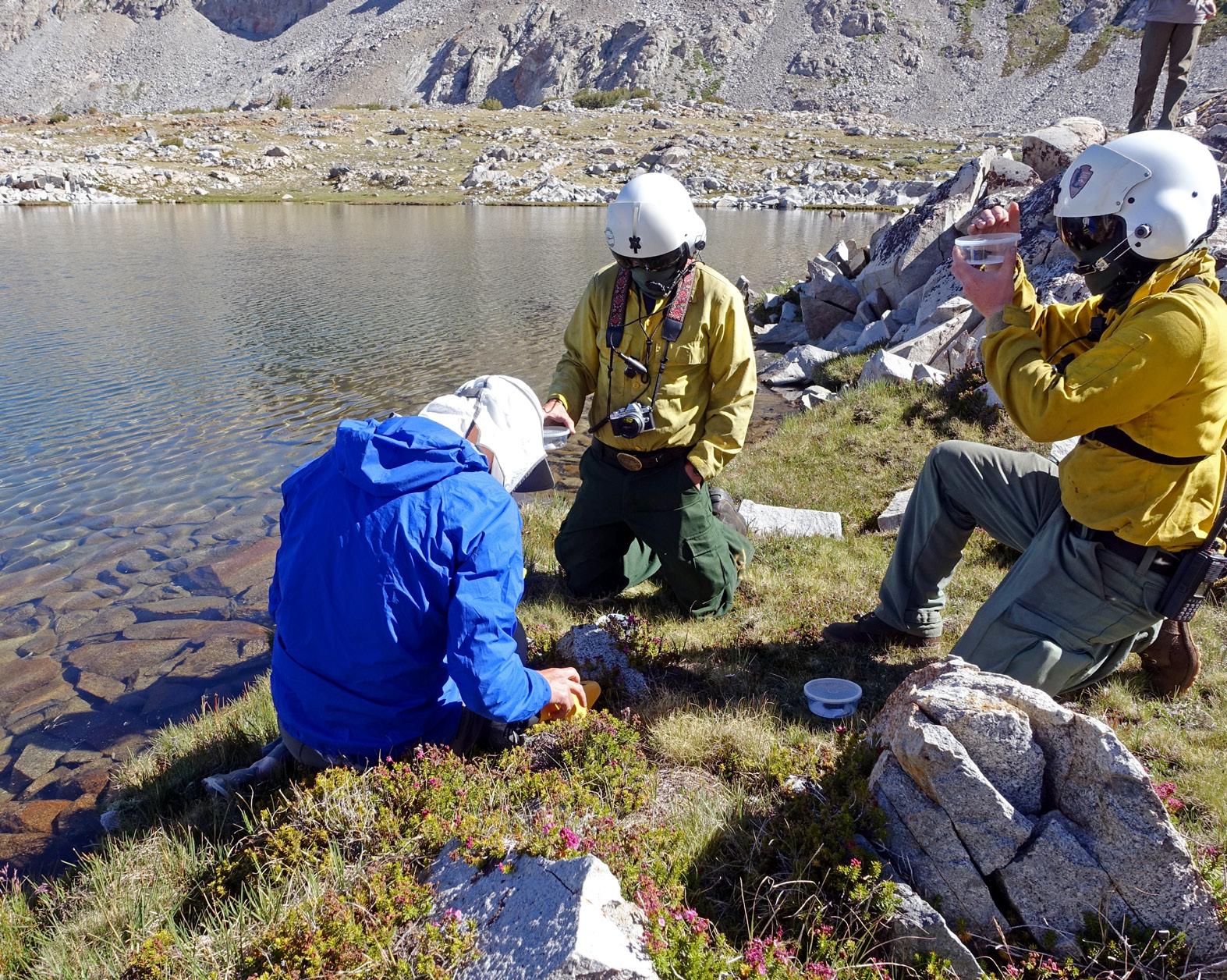
Now, biologists are working to improve the bighorns’ prospects. They use GPS collars and on-the-ground surveys to monitor the bighorns, and they sometimes bring in sheep from larger populations elsewhere in the Sierra Nevada to increase herd numbers and genetic diversity. As of the end of the 2020 field season, there were 71 bighorns in the Yosemite-area herds.
Researchers have faced setbacks over the years, including harsh winters that decimated the herds, but they continue to push toward the goal of a self-sustaining bighorn population. “Endangered species projects take time and involve taking risks,” Yosemite biologist Sarah Stock wrote in a recap of the 2020 bighorn study season. “A large population can ride out threats, such as extreme weather events and predation, but a small population requires more time to rebound and grow their population again.”
Saving a species is a long-term endeavor. Without Conservancy donors’ resolute support for research and restoration, bighorns and yellow-legged frogs might still be missing from the park. And just as researchers rely on perseverance, funding longterm projects requires seeing the bigger picture and embracing patience. Sally Mode, a trustee of the Arthur L. and Elaine V. Johnson Foundation — a major funder of the bighorn project in recent years — acknowledges, “Some things you fund can’t be compartmentalized with a start and end date, and they can’t all be successful.” To that end, she stressed, “Resilience is nothing if it’s not paired with optimism.”
“All aspects of protecting or reintroducing a species must be considered, and that takes time,” says Conservancy donor Janie Leifhelm, who helps fund the bighorn project. She appreciates not only the bighorns’ resilience, but also the researchers’ commitment to making sure the herds can endure on their own. “The research team will have successes but also some failures,” she says. “But hopefully knowing how critical their work is will keep them going.”
Bighorns and yellow-legged frogs are back in Yosemite, but the work to ensure their long-term survival continues. If you could scan the high country on a summer day this year, you might spy an aquatic ecologist collecting water samples from a mountain lake, or a biologist crouched on a ledge, scanning for sheep. With donors’ support, those researchers are studying the still-endangered species and making the populations more robust.
Bighorns, frogs and other threatened or endangered species in the park face a variety of challenges, from predators to disease to wildfires, but they live in protected, intact habitat. In areas fragmented by roads and buildings, vulnerable species face even greater hurdles to bouncing back. That makes supporting wildlife work in Yosemite, where populations can rebuild and thrive in a healthy ecosystem, ever more critical. And while the results take time, rebuilding resilience for species such as bighorns and yellow-legged frogs in their historical terrain is worth the wait.
TUOLUMNE MEADOWS: Snapshots in Time
BY CORY GOEHRING, Lead Naturalist, Yosemite Conservancy
In Yosemite’s Tuolumne Meadows, a scenic subalpine stretch just off Tioga Road, you can watch the Tuolumne River wind along its serpentine journey from eastern Sierra Nevada headwaters to Hetch Hetchy and western California. At this high elevation (8,400 feet), snowmelt and aquifers nourish diverse species, including willows, sedges, mule deer, songbirds, ground squirrels and butterflies. Smooth granite domes swell above the meadows, and the Cathedral Range’s high peaks jut up over pine forests to the south.
Yosemite’s First People have called this land home for over 4,000 years. For millennia, they have maintained a reciprocal relationship with the land, water, plants and animals. They managed and tended these relationships through their spiritual and ecological knowledge. For generations, Tuolumne Meadows was an important trading (includes social) area for the Paiute, Southern Sierra Miwuk and other tribes. Items, such as acorns, baskets, beads, obsidian, pine nuts, moth larvae, fly pupae and salt, were exchanged by tribes on both sides of the Sierra. Today, the tribes commemorate this history with an annual hike along the trade routes created by their ancestors.
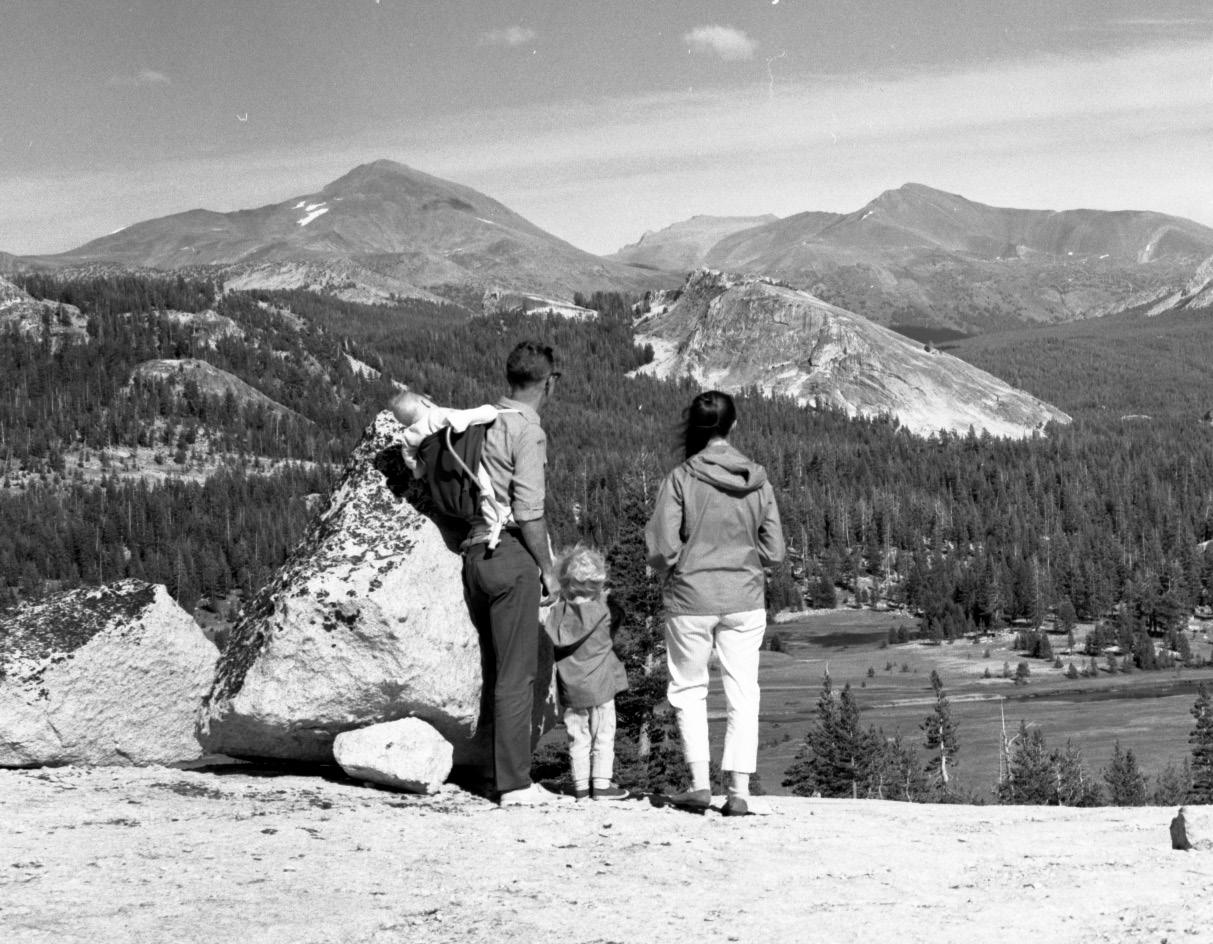


In the mid-1800s, new arrivals — surveyors, miners, sheepherders — brought rapid changes to the high country. Thousands of domestic sheep were herded into Tuolumne Meadows to graze on lush summer vegetation. The Great Sierra Wagon Road, precursor to today’s Tioga Road, was built as a conduit for mining supplies. A homesteader, John Baptiste Lembert, claimed 160 acres and built a cabin.
Alongside these shifts, another current flowed. Conservationists and political players were promoting the scenic and ecological value of unbuilt land. They helped spur the 1864 Yosemite Grant Act, which designated Yosemite Valley and Mariposa Grove as public land. In 1890, another legislative act established Yosemite National Park, extending government protection to Tuolumne Meadows and beyond.

PHOTOS The Tuolumne Meadows area, in Yosemite’s high country, is an important site for Native Americans, going back thousands of years. The area has changed dramatically in recent human history: In the 1800s, herders arrived with sheep, as shown in the undated photo at center. In the late 1880s, John Lembert built a small structure around part of Soda Springs, a natural spring in the meadows, to protect the bubbling mineral water from livestock. (The remains of that log building, pictured above, are still standing.) Since Yosemite National Park was established in 1890, Tuolumne Meadows has become a popular summer destination. At left, a family takes in the view from Pothole Dome, at the western edge of the meadows, in 1967.

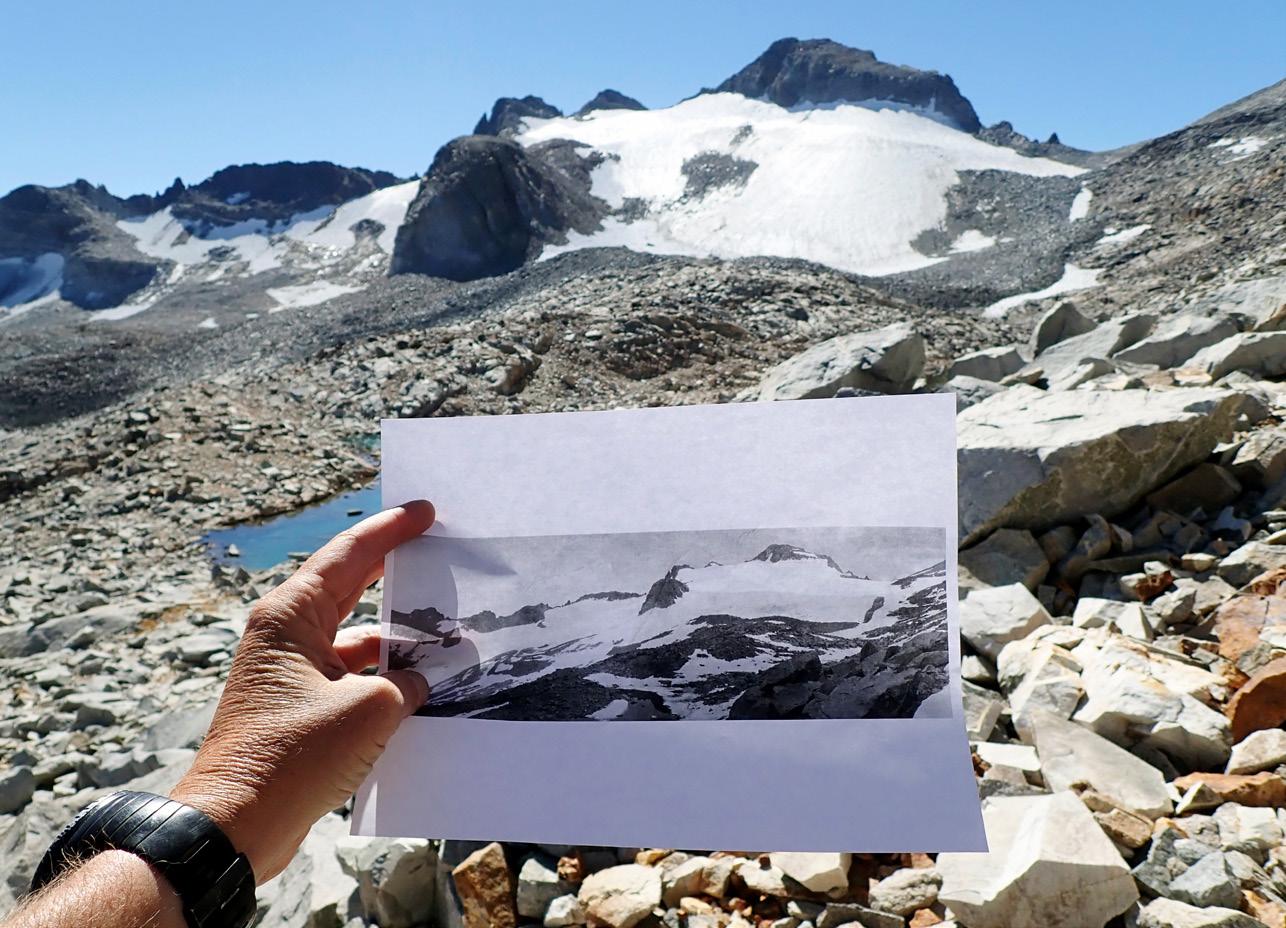
& BOTTOM Today’s Tuolumne landscape is marked by granite domes and peaks, open meadows, clear water and evergreens. Throughout this area, as elsewhere in Yosemite, you’ll find evidence of ancient glaciers: polished rock, erratic boulders, craggy ridges that stood above the powerful ice as it smoothed lower slopes. Modernday glacial ice on mounts Lyell and Maclure, remnants of the more recent “Little Ice Age” of the 1300s–1800s, helps feed the Tuolumne River. As that ice dwindles, the future of the river and surrounding ecosystem is uncertain. The west lobe of the Lyell Glacier, shown above, lost about 70% of its surface area between 1903, when the black and white photo was taken, and 2018.
Tuolumne Meadows is a subalpine haven for biodiversity, and in the past century, we’ve learned more and more about the intricate processes and relationships that shape this ecosystem. For example, scientists once believed pesticides were necessary to eliminate the area’s endemic needle miners (Coleotechnites milleri), which feed on lodgepole pines. Now, we understand these small gray moths play an essential role in regulating the pine population and protecting the meadows.
The Tuolumne landscape has undergone notable shifts in the past 200 years, from a thriving meadow system and trading post, to a livestock-grazing destination and mining thoroughfare, to a federally protected ecosystem where visitors flock to campsites and carefully maintained trails. Today, this area, like the rest of Yosemite and the Sierra Nevada, faces more transformation. As the climate changes, Yosemite’s high country is evolving: Glaciers are retreating, the snowpack is dwindling, and species accustomed to lower elevations are climbing higher up the mountains to reach cooler temperatures. What does the future hold for this landscape?
Yosemite Conservancy supporters have a key role to play in ensuring scientists, ecologists and resource managers can continue working to understand, protect and, when necessary, restore the Tuolumne Meadows area. In recent years, donor-funded projects have focused on protecting biodiversity by keeping invasive plants in check, and on rehabilitating parched wetland habitat at the base of Pothole Dome. Conservancy volunteers have helped remove non-native plants and informal trails that threaten meadow resilience.
Of course, Tuolumne Meadows isn’t the only part of Yosemite facing, and already undergoing, significant change. Throughout the park, the Conservancy community supports efforts to study and safeguard wetlands, woodlands, wildlife and more. Donors are also funding projects anchored in American Indians’ ongoing relationships with this land, such as documenting the history and culture of the Bridgeport Indian Colony, in the eastern Sierra Nevada, and working with Yosemite-area tribes to bring traditional stewardship back to the Valley’s oak groves.
Much remains unknown and unpredictable about the future of Tuolumne Meadows and the broader Yosemite area, but one thing is certain: Each of us can play a part in protecting the park. By supporting research, restoration and education; by learning about and from the history of this place; and by striving to minimize individual impacts; we can work together to ensure Yosemite is as resilient as possible.
Protecting Meadow Ecosystems
Follow designated trails. Footsteps can fragment a meadow. Stick to formal trails to avoid trampling plants and tamping down soil.
Leave plants in place.
Instead of picking that pretty flower, snap a pic!
Opt for durable surfaces. Pick hard ground or rock for your picnic spot or tent site.
Clean your gear.
Before and after a meadow visit, brush off your shoes, clothes and backpack to remove any invasive seeds that might have hitched a ride.


Staying Curious,
FROM A DISTANCE
“I wanna know, why is grass green?”
obby, 4, had called in from Washington to pose his latest question to rangers Anastasia Roy and Adam Ramsey, hosts of the live “Kids Ask Rangers” show that aired on Yosemite National Park’s Facebook page last spring. Miles, 6, mused from North Carolina: “How do trees grow?”
Broadcasting from the “Ranger Couch” in their house, the two rangers carefully considered questions from Robby, Miles and other curious kids on the topic of the week — green things — and explained how chlorophyll
makes plants green and helps them grow. From early April to late May 2020, Roy and Ramsey produced eight episodes, delivering Yosemite-themed lessons to young learners around the world, as COVID-19 disrupted travel and park trips.
Pre-pandemic, Yosemite rangers generally answered kids’ questions during in-person talks, on guided walks and while handing out Junior Ranger badges. In 2020, in response to public health guidance, they focused on creating opportunities for children to learn from afar,
resulting in “Kids Ask Rangers,” drawing prompts, a living-room campout and a virtual program through which aspiring Junior Rangers could earn their badges from home. By the end of December, those online programs had reached hundreds of thousands of people.
Shifting to online outreach, Roy says, has reinforced the value of reaching students where they are, from Washington to North Carolina, and tying Yosemite-themed lessons to their interests and home environments. Roy and Ramsey focused on bringing nature-based, learner-driven education to young children. WildLink, another Conservancy-funded youth program, applied that concept to older students, by developing a new web-based curriculum for its partner high schools.
Virtual learning is a clear departure from WildLink’s usual outdoor expeditions, but program leaders say it has created space for students to delve more deeply into environmental justice and local conservation. The online curriculum incorporates core elements of the WildLink approach, including wilderness-focused lessons, community-based environmental projects and career exploration.
Other Conservancy-supported youth programs have similarly embraced a mix of digital and community-oriented activities in the past year. In addition to shifting to a virtual learning platform, the team behind the two-year Yosemite

Leadership Program (YLP) at the University of California, Merced, identified capstone projects that participants could complete close to home or online, such as producing videos for the UC Natural Reserve System and for Cumbres de Monterrey, a Yosemite “sister park” in Mexico. Meanwhile, undergraduate “student rangers,” who usually staff UC Merced’s on-campus Wilderness Education Center (WEC) and lead field trips for local elementary schools, designed and delivered virtual Yosemite experiences for more than 1,200 Merced-area students.
While program leaders are eager to get back to group hikes and high-fives, they’ve observed some advantages to online outreach. Digital tools can help educators and rangers bring Yosemite’s inspirational power to people who might not have easy access to the park.
“I am particularly excited to see how virtual experiences can help prepare underrepresented communities to access national parks and wilderness more safely and comfortably,” YLP Co-Director and WEC Director Jesse Chakrin wrote in a reflection on his team’s 2020 programs. “Of primary interest is how virtual field trips may reduce mental and emotional barriers to feelings of belonging in the natural world for non-traditional visitors.”
This year, with support from Conservancy donors, the NPS is investing in virtual interpretation as part of Yosemite’s


long-term educational plans. In mid-March, Roy got to step inside the new Virtual Learning Lab in Yosemite Valley, a high-tech studio space with green screens, macro lenses to zoom in on cones and feathers, 360-degree video equipment, and live-streaming broadcast equipment.
The idea for the studio took root well before the pandemic pushed park education online, Roy says. She and a fellow ranger drew inspiration from distance-learning programs at the Grand Canyon, where they saw the power of bringing an iconic park to people who couldn’t visit in person.
“It’s way more dynamic than a Zoom call!” Roy says. The new studio’s production tools are a step up from laptopbased video lessons, and from last spring’s “Kids Ask Rangers” home set-up. She sees the new learning lab as an opportunity for Yosemite educators to “think beyond field trips” and apply tactics honed through pandemicera programs: Bridge time zones and miles, listen to what
sparks learners’ curiosity, and encourage people to connect with nature wherever they are.
For the studio’s first few months, Roy is working with a recent UC Merced (and YLP) graduate to develop and deliver lessons for students across the U.S. Ultimately, many more Yosemite-based educators and communicators, including Conservancy staff, will be able to use the learning lab to record videos, produce podcasts, and lead interactive programs for classrooms and community groups.
Not all the park’s 2020 educational adaptations took place online. Innovation also flourished in in-person education, thanks to a series of Conservancy-funded “popup” programs. Plans to experiment with pop-up activities, which visitors can happen upon as they explore the park, started taking shape in 2019. In a silver lining from a strange year, these largely unstaffed, audience-driven experiences proved even more valuable in 2020 than
had been envisioned. From postcard-writing stations to painting prompts to a telescope aimed at far-off glacial ice, the outdoor pop-up programs helped more than 14,000 people learn about the park in creative ways while staying a safe distance from others.
Whether in-person or online, donor-supported education looked different in 2020, and adaptations to the pandemic fostered fresh ways for people to learn about, and from, Yosemite. Pop-up programs encouraged visitors to learn at their own pace, through short activities that adapt easily to different ages and backgrounds. Live-streamed lessons planted seeds of stewardship in minds 1,000 miles from the park, helping people appreciate not just Yosemite, but also the natural world in their own neighborhoods and local parks.
Conservancy-supported programs, such as WildLink, YLP and Junior Rangers, won’t stay online forever, of course. When safe, students will be back in Yosemite for camping trips, nature walks and other activities. But increased online outreach, pop-up programs and the new learning lab could prove to be valuable, enduring resources for expanding the park’s educational reach.

ABOVE At the new donor-funded “Virtual Learning Lab” in Yosemite Valley, a green screen and broadcast equipment let educators and others from the NPS and its partners record and stream videos, lessons, interactive programs and more.
According to Roy, one of the biggest lessons from the past year — one fueled by Robby, Miles and countless other kids — is the importance of finding new ways to help people connect with Yosemite. Or, to borrow the closing line from each “Kids Ask Rangers” episode: Stay curious.
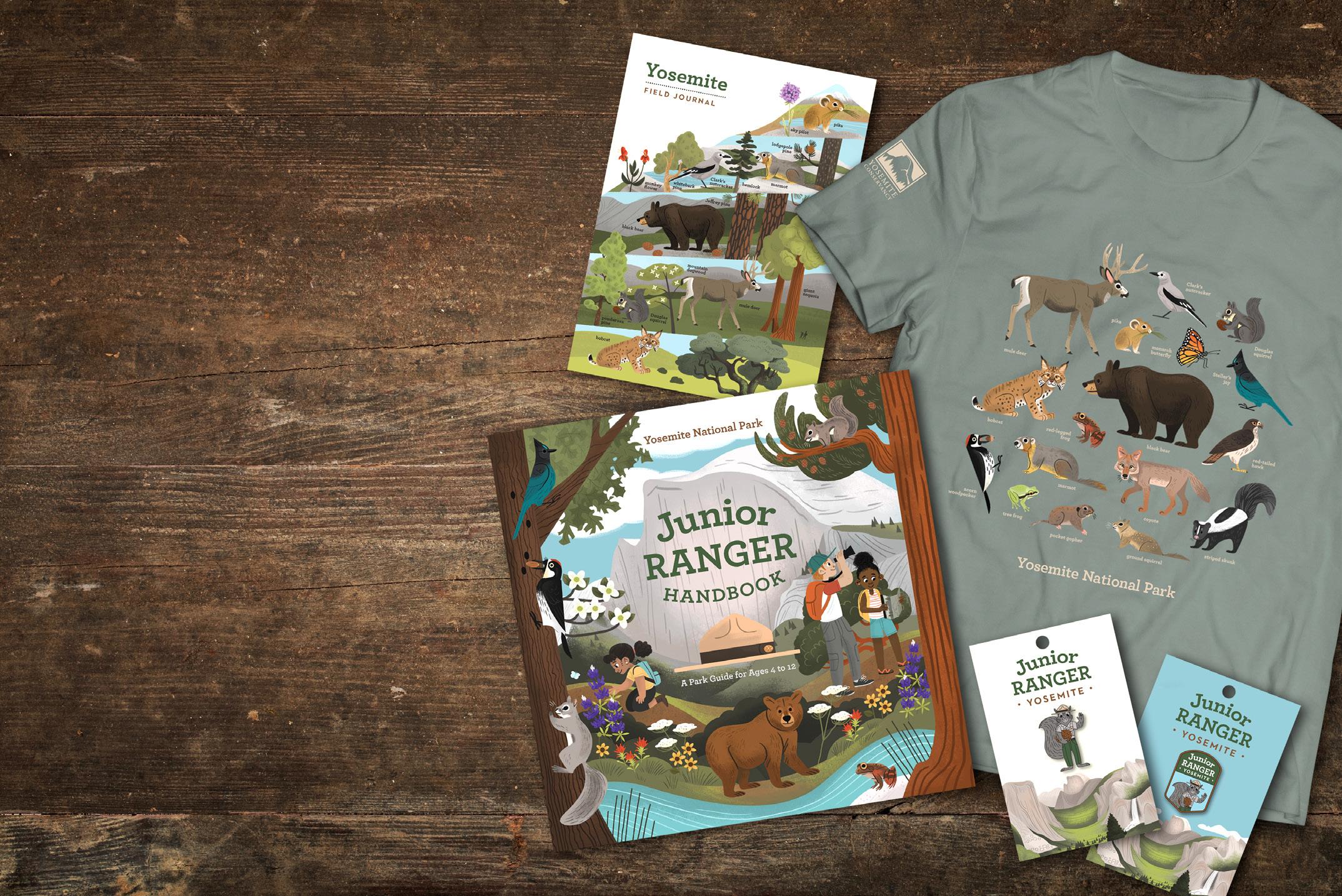
Yosemite Has a New Junior Ranger Program
Celebrating 50 Years OF LEARNING IN YOSEMITE
by Pete Devine, longtime naturalistome of you may have memories of 1971, that halcyon era shortly after dinosaurs disappeared. Nixon was in the White House, six more people went to the moon, and gas was $0.36/gallon.
The National Park Service (NPS) was a spry 55, and Yosemite had been a national park for eight decades (and a geologic wonder for millions of years). A then-record 2.3 million people passed through the park’s gates that year. They came for many reasons — to sightsee, hike, camp, climb, bird, picnic, sketch — but they were, perhaps, linked by the curiosity and wonder this place instills.
At the time, the Yosemite Natural History Association (YNHA) — predecessor of Yosemite Conservancy — was nearing its semicentennial.



ABOVE The June 1971 issue of Yosemite Nature Notes, the Yosemite Natural History Association periodical, announced the launch of the Field Seminar Program; the following September, the publication highlighted annual growth in seminar enrollment, from 71 to 251 students.
In the 1920s, the association had helped launch a parkfocused periodical, Yosemite Nature Notes, and Yosemite-based educational programs. By 1971, the association was in a bit of a slump, and leaders saw a need and opportunity to revitalize it by expanding interpretive services in Yosemite.
And so, under the leadership of NPS Chief Naturalist William Jones and business manager Henry Berrey, YNHA created the Yosemite Field Seminar program. That first summer, 1971, featured five courses: two on nature-based interpretation and three on Yosemite’s alpine zone. Despite the inherent limitations of the analog advertising tools available to the YNHA in the ’70s, word got out. The inaugural courses attracted 71 students, with eager learners coming from as far away as Ohio and Illinois. By the next summer, course offerings had grown to 12 seminars, with 251 participants.
The Yosemite Field Seminar program had a predecessor in the prestigious Yosemite School of Field Natural History (often called the Yosemite Field School), which was run by the NPS with help from the YNHA. More than casual naturalizing, the Field School’s seven-week courses were oriented to teachers, academics and nascent park rangers. The school ran from 1925 until 1953, when shifts in NPS priorities and career paths suggested the idea had run its course.
During its 28 years, the Yosemite Field School produced many talented and passionate park professionals. After graduating from
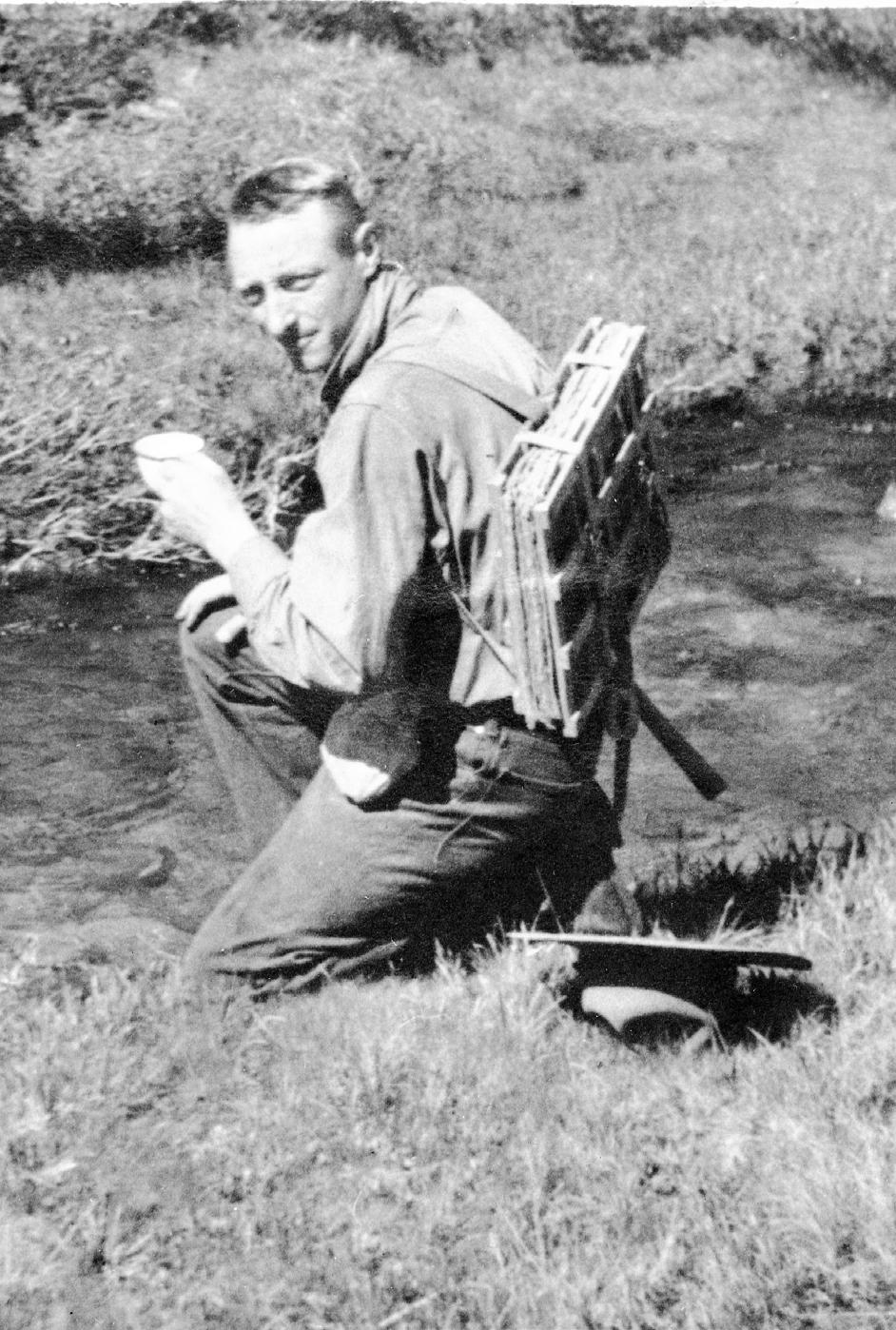

OPPOSITE Participants in the Yosemite School of Field Natural History explored the Volgelsang Area in July 1935. The Field School (1925–1953), a predecessor of the Yosemite Field Seminars and Yosemite Conservancy’s Outdoor Adventures, offered seven-week courses for aspiring naturalists and scholars.
ABOVE Ranger-naturalists Carl Sharsmith (top, in 1938) and Lloyd Brubaker (bottom, in 1955) both dedicated decades to sharing their knowledge and curiosity about the natural world with park visitors and peers; they were the inaugural instructors for the Yosemite Field Seminar program when it launched in the 1970s.
the Field School in 1930, Carl Sharsmith went on to renown as a botany professor, a beloved summer ranger and naturalist in Tuolumne Meadows, and an inaugural instructor for YNHA’s Yosemite Field Seminars. I was fortunate to enroll in one of Sharsmith’s field seminars when I first arrived in Yosemite in 1985; his final high country presentation was a yearlong training session for my faculty when I was the education director for Yosemite Institute (now NatureBridge).
Another Field School graduate, Beatrice “Bettie” Willard (class of 1948), went on to join the Rocky Mountain Nature Association (now Rocky Mountain Conservancy), where, in the early 1960s, she started the National Park System’s first field seminar program oriented toward visitors, rather than aspiring rangers and professional naturalists. Eight years later, YNHA’s Yosemite Field Seminar program became the second such educational program run by a cooperating association. Those early models have since inspired similar visitor-focused field programs at many other NPS sites, including Yellowstone, Grand Canyon, Joshua Tree and Point Reyes.
Since my first YNHA field seminar with Carl all those
Farewell to Pete
BY ADONIA RIPPLE, Chief of Yosemite Operations, Yosemite Conservancyyears ago, I’ve been lucky to follow in his alpine boot prints. In my 36 years in the park, teaching field seminars and directing the education programs of Yosemite Institute and then Yosemite Conservancy, I’ve led thousands of people on immersive educational experiences, from birding workshops in Yosemite Valley to geology courses at Lyell and Maclure glaciers. I even had the privilege of welcoming Carl’s fellow field seminar instructor, longtime Yosemite ranger-naturalist Lloyd Brubaker, as a student in one of the many woodpecker-focused courses I taught for the Conservancy through the years.
The past 50 years have seen dramatic changes in the park, our nation and the world — and within our organization. YNHA became Yosemite Association and then merged with a fundraising arm to become today’s Yosemite Conservancy. Annual park visitation has doubled since 1971.
What hasn’t changed since Yosemite Field Seminars began half a century ago is that our organization remains dedicated to serving the park and the public with diverse, in-depth educational outings. The field seminars continue today as Yosemite Conservancy’s Outdoor
When Pete Devine retires in May, Yosemite will be losing one of its great masters of interpretation. More than this, we will be losing a great sage of how to live a great Sierra life. Pete has mentored countless naturalists during his career in the park with both Yosemite Institute and Yosemite Conservancy. For all who have walked with him, be they budding naturalist educators or families visiting the park for the first time, we are forever changed by the Pete perspective: the subtle humor that is hilarious to anyone paying attention, the ability to make you curious, the gentle way he made this place come totally alive by helping us understand everything from feather to leaf to those who have walked these trails well before us. Often seen biking up thousands of feet of elevation without breaking a sweat, or using his long hiking stride that is five steps long to mere mortals, Pete’s centered and calm nature makes everything look easy. It is difficult to think of this park without Pete. From someone who has gotten to work for him and with him for nearly 25 years, I am thankful for the gift of insight to the natural world and the colorful cultural history of this place, and for him being a patient mentor who helped generations of us become better than we were.
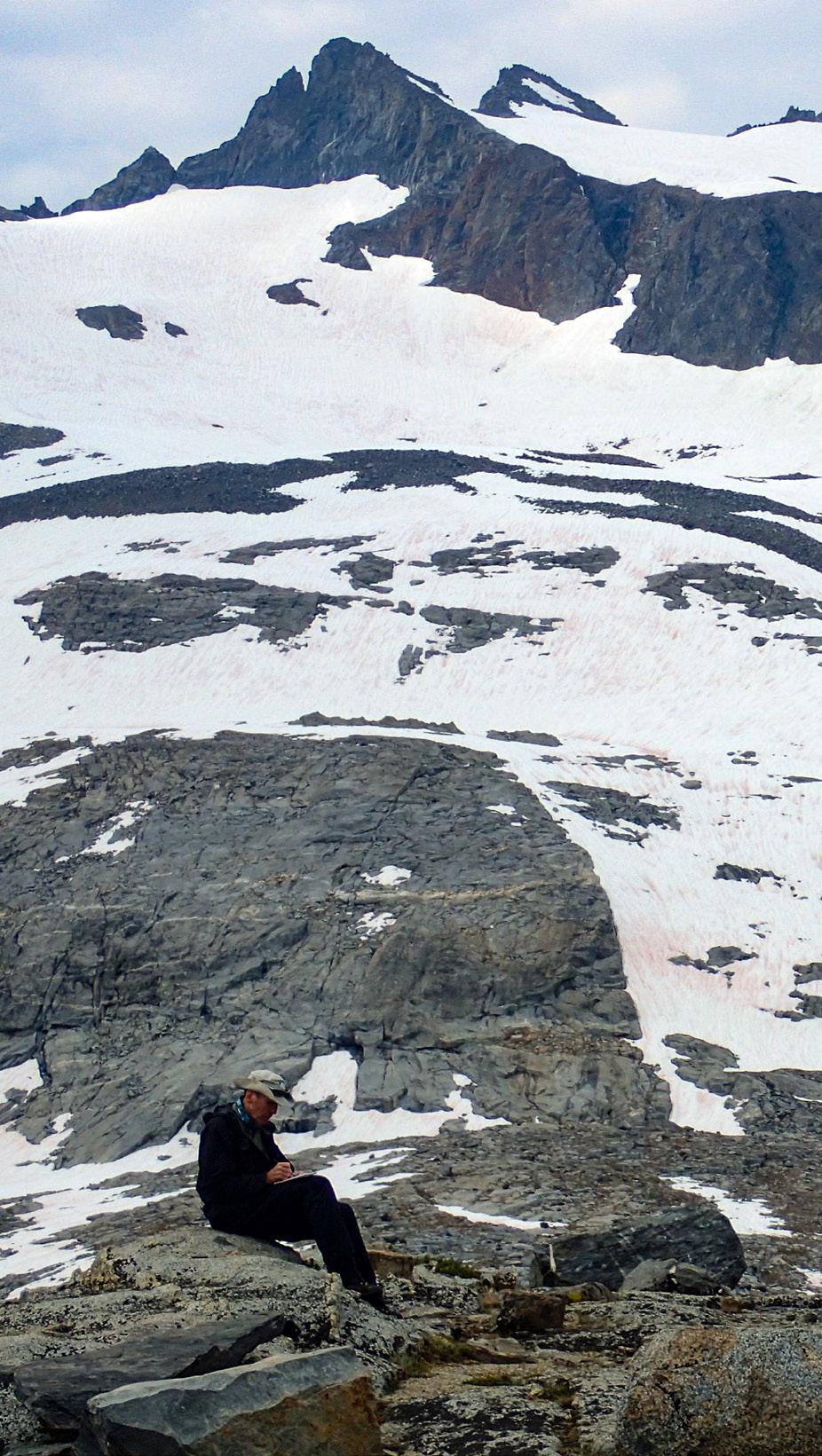
Adventures, which aim to augment the NPS, goals of cultivating an informed and caring constituency of Yosemite stakeholders and stewards.
Today, our programs create opportunities for visitors to explore an array of topics, including American Indian culture, alpine ecology, botany, astronomy and ecology, through backpacking treks, snowshoe outings, day hikes, art retreats, birding walks, photography workshops and more. We also provide public interpretive programs and customized outings for individuals and families, and we work with travel companies, such as National Geographic and Backroads, to offer educational experiences for tour groups.

JUNE 3–4
Adventure Combo: Stargazing and Biking (Trip 3 )
JUNE 10–12
Yosemite Field School: Bird-Banding
JUNE 17–20
Backpack: Glen Aulin
JUNE 25–27
Intro to Backpacking: Southern Yosemite Secret Waterfall
JULY 9
Little Devils Post Pile Day Hike: Tuolumne Meadows
JULY 10–11
Overnight Under the Stars (Trip 1)
It’s my very strong sense that the people who initiated the Yosemite Field School in 1971 would approve of how their program has grown, adapted and evolved. Fifty years later, people from across the country and around the world still love Yosemite, and our organization is still here to help them deepen their connection with, understanding of and appreciation for this remarkable park. Visit
JULY 15–18
Backpack: Clouds Rest Through-Hike
JULY 16–17
Adventure Combo: Stargazing and Biking (Trip 4)
JULY 22–25
Backpack: Yosemite Creek to Eagle Peak
JULY 23
Full Moon Hike: Taft Point (Trip 1)
JULY 24–25
Day Hikes: Tuolumne Birds and Blooms
JULY 29–AUGUST 1
Yosemite Field Institute: Lyell Glacier Backpack
AUGUST 5–8
Intro Backpack: May Lake Story Stroll
AUGUST 6–8
Yosemite Field Institute: Alpine Ecology
AUGUST 12–13
Overnight Under the Stars: Perseids Meteor Shower! (Trip 1)
AUGUST 12–15
Backpack: Clouds Rest (Two Nights)
AUGUST 13–14
Overnight Under the Stars: Perseids Meteor Shower! (Trip 2)
AUGUST 14–15
Overnight Under the Stars: Perseids Meteor Shower! (Trip 3)
AUGUST 19–20
Geology of Tuolumne Meadows
AUGUST 19–22
Backpack: Mt. Conness
AUGUST 26–29
Ten Lakes and Grant Lake: Backpack
AUGUST 26–29
Yosemite Field School: Bighorn Sheep Backpack
AUGUST 28–29
Yosemite Field Institute: High Country History
Adventures.
New Grants for 2021
TRAIL REHABILITATION & ACCESS
California Conservation Corps Fully Funded
Half Dome Corridor Restoration
Tenaya Lake Loop Trail
Yosemite Valley Trails
WILDLIFE MANAGEMENT
Amphibian Conservation
Bighorn Sheep: Saving a Species
Fisher Habitat Study
Mountain Lion Research
Peregrine Falcon Protection
Sierra Nevada Red Fox Research
Songbird Science
HABITAT RESTORATION
Ackerson Meadow: Restoration Planning
$329,000
$320,330
$200,000
$375,000
$52,000
$175,000
$95,000
$56,000
$85,000
$60,000
$129,776
California Black Oaks: Tribal Stewardship $145,100 Keep It Wild $176,629
Lower Cathedral Meadow Restoration $133,189
Merced Grove: Saving Sequoias
SCIENTIFIC RESEARCH
Saving Sierra Nevada Pines
Wilderness Research: PCT/JMT
Yosemite Science Strategy
CULTURAL & HISTORIC PRESERVATION
African American History in Yosemite
Celebrating Chiura Obata
Digital Archives: Maps and Drawings
Wahhoga: Safety and Education
Yosemite History Center: Inclusive Education
$174,783
$55,900
$78,600
$76,371
$64,400
$30,000
$120,000
$25,300
Getting Back to Giving Back
BY EMILY BROSK, Director of Volunteer Programs, Yosemite Conservancyosemite is a dynamic place, devoid of dull moments. Depending on the season, “normal” activities in the park might be interrupted by wildfires and smoky skies, lightning storms, floods, super strong winds, branch-breaking snow, or federal government shutdowns.
$75,950 Yosemite’s Horses and Mules
VISITOR SERVICES & EDUCATION
Adventure Risk Challenge
Ánimo Ralph Bunche High School Eco Club*
Ask a Climber
Climbing Stewardship Program
Electric Vehicle Charging Stations
Entrance Station Network Upgrades
Junior Ranger Program
Parks in Focus®
Parsons Memorial Lodge Summer Series
Preventive Search and Rescue
Spanish Self-Guided Tours
Tenaya Lake Signs
The Yosemite Museum’s Second Century
Trip-Planning Video: One Day in Yosemite
Veterans Seminar in Yosemite
Virtual Learning Labs
WildLink
Yosemite Bike Share
Yosemite Leadership Program and Wilderness Education Center
Yosemite Nature Notes
$40,000
$80,000
$6,100
$68,000
$130,000
$120,000
$100,000
$137,700
$24,000
$15,000
$50,000
$12,500
$55,000
$300,000
$7,000
$8,500
$135,318
$50,000
$60,000
$160,400
$26,000 Yosemite
The generous people who donate their time to volunteer with Yosemite Conservancy in the park know this place is inherently unpredictable, as does our volunteer program team. But, as 2020 taught us, there’s always another surprise waiting for us.
As it turns out, programs that depend on physical proximity, including communal camping, don’t hold up particularly well to COVID-19 safety restrictions. We considered alternate ways to run our volunteer programs without endangering participants, but we ultimately opted to pause for the 2020 season to ensure the health and safety of all. That meant no volunteer information assistants in their bright blue shirts stationed in parking lots waiting to assist eager visitors, and no work week crews digging in on trail and habitat projects.
It also meant no volunteer appreciation dinners, often a highlight of a “normal” season — but even though they weren’t in the park, our 2020 volunteers were certainly appreciated!
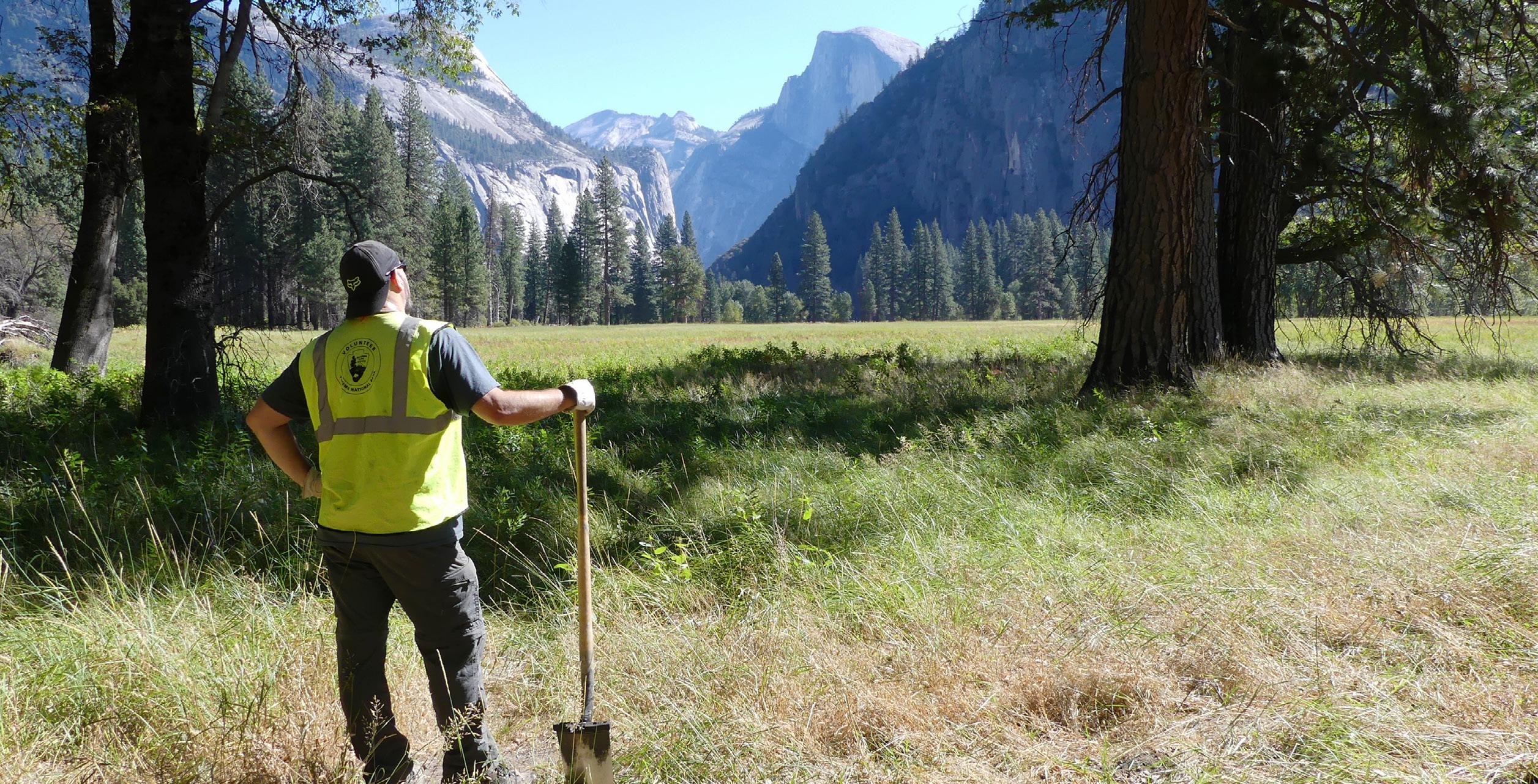
Our passionate and dedicated volunteer crews stayed connected to Yosemite, to one another and to our team through monthly Zoom meetings during the summer season, which we hosted live from Cook’s Meadow. Our most memorable meeting featured a few special guests: a family of black bears, mule deer bucks with full and fuzzy racks, and loud birds that seemed to pipe up to interrupt at all the right moments. In fact, Cook’s Meadow turned out to be a hot spot for viewing wildlife, thanks to drastically reduced visitation, fewer cars and a notably abundant crop of acorns from the Valley’s black oaks.
While it was a unique experience to share wildlife sightings and other special moments over video chat with our volunteers during a stressful year, it was heartbreaking to hear how much people missed coming to the park to give back. No matter how good your Wi-Fi connection or how crystal-clear the video quality, there is no match for being in Yosemite, smelling the warm summer breeze, hearing a family of ducks land in the Merced River, or feeling the jolt of surprise after rounding a corner and finding a bear gobbling down acorns.
We were all hoping 2021 would look more like a “normal” year — but much remains uncertain, including how — and how much, we’ll need to adjust our volunteer operations. We’re thrilled to be able to restart our visitor information and work week programs this season, but we’re sad we
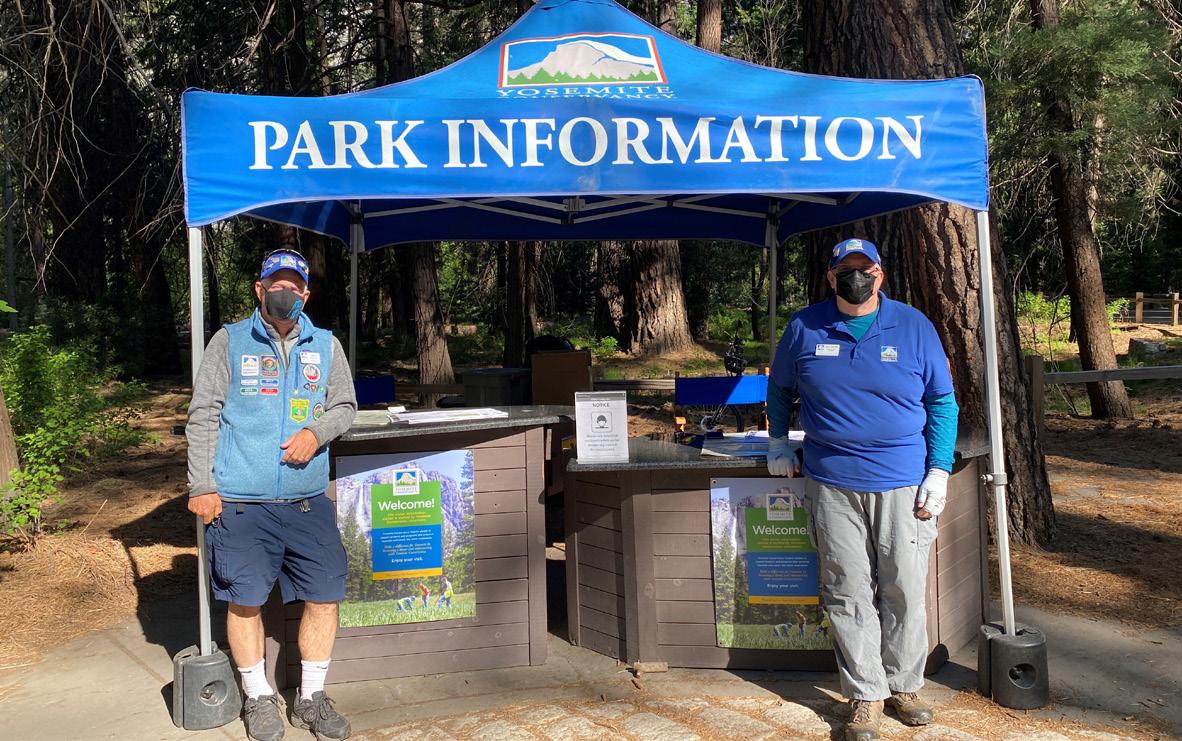
likely won’t be shaking hands, high-fiving or hugging our longtime volunteers, as we welcome them back to the park.
We will, however, greet our volunteers with smiles under face masks and plenty of hand sanitizer! This summer, visitors will get valuable information from our volunteers at two day-use parking lots in Yosemite Valley, at the junction of the Mist and John Muir trails, in Wawona, and at Tuolumne Meadows. Volunteer information booths will feature plexiglass barriers, signs and ground markings to encourage safe distancing, and large printed maps that
visitors can photograph. Meanwhile, our work week crews will be pitching in at Ackerson Meadow, the focus of a Conservancy-supported restoration effort.
Time and time again, the Conservancy’s volunteer programs have proved their value: On average, they add up to $450,000 per year in donated time, knowledge and sweat. During the past three decades, our volunteers have helped restore meadows and trails, created access routes for climbing areas, and connected with tens of thousands of curious — and sometimes lost — visitors. Yosemite needs these programs, and we know from the past year that volunteers are eager to get back to giving back.
No matter what the 2021 season brings — continued pandemic precautions, fires, rockfalls, storms — this year will undoubtedly be another opportunity for our programs’ staff and participants to show off their resilience and adaptability. While our volunteers adapt to new protocols, we will continue to adjust our approach to best suit the needs of Yosemite and all who visit.

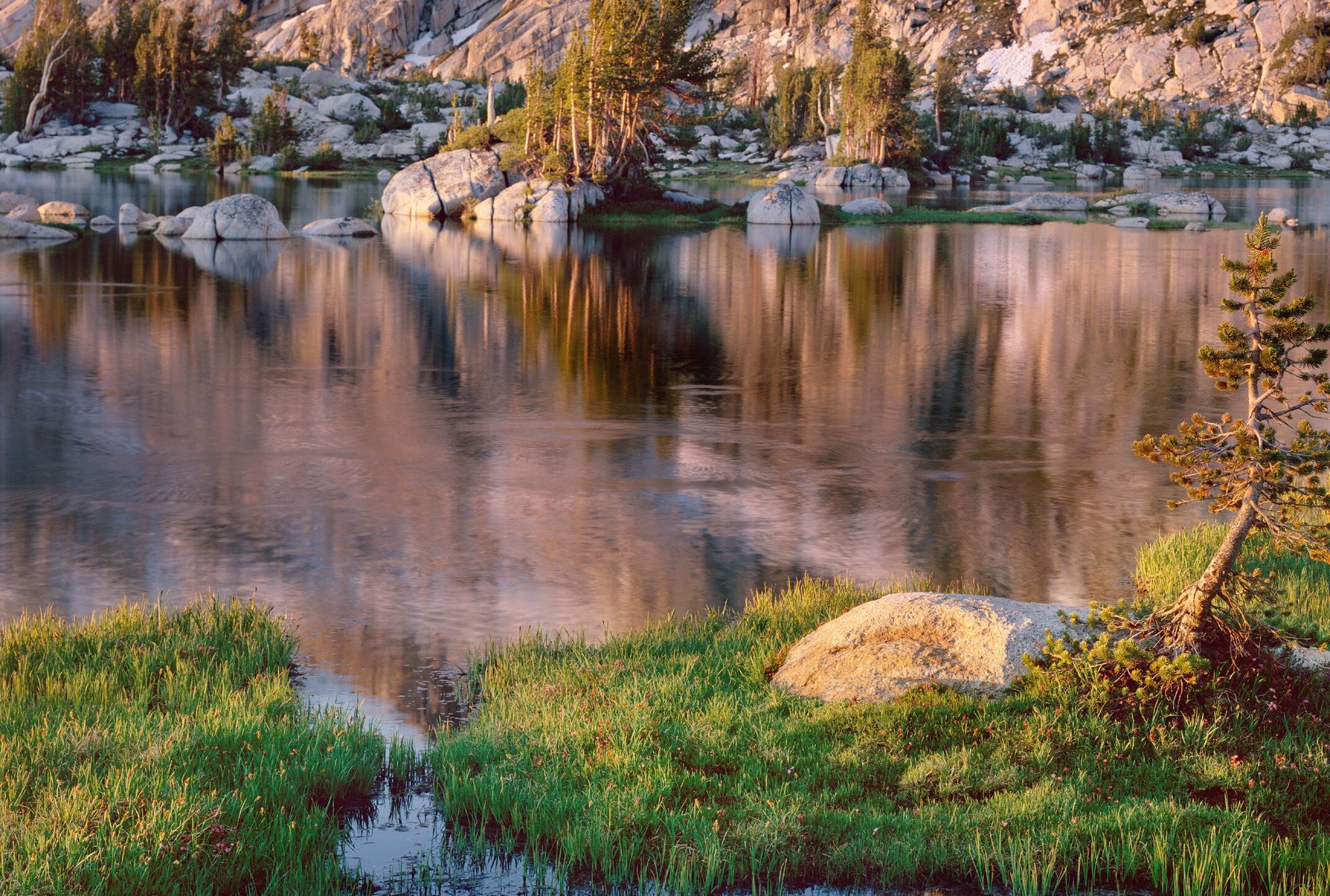

duringouhelpsustainYosemiteNationalPark importantchallengingtimes.Yoursupportfunds workthroughoutthepark— visitoreverythingfromrehabilitatingtrails,toproviding researcheducation,toprotectingwildlifethrough and habitat restoration.
YourgifttodayhelpspreserveandprotectYosemite. Yourgiftistax-deductibletotheextentallowedbylaw.
Tax ID No. 94-3058041info@yosemite.org

Meet the Team: Nicole Brocchini
f you’ve visited the Conservancy website in the past few months, you might have come across a new addition to our online operations: a virtual version of the Yosemite Museum Store.
Nicole Brocchini, the person behind that new web resource, has deep roots in Yosemite and a long history with the Conservancy. She started her current role as supervisor of the Yosemite Museum Store in 2000. We chatted with Nicole about …
her love for the park.
My connection to Yosemite is, literally, in my blood. Among other tribes and nationalities, I am of the Southern Sierra Miwok Nation through my father’s family. Being in a place I know my ancestors have been in for centuries makes me feel so connected to this piece of the Earth.
how her Conservancy role has shifted in the past year. Since the Yosemite Museum and its store have been closed during pandemic, I transitioned to supporting the Conservancy’s walk-up bookstore at the Valley Visitor Center, which is a very different retail experience from my usual role. Toward the end of 2020, I launched

the online version of the museum store, as part of the Conservancy’s webstore.
the work she features in the museum store.
About 95% of the pieces are handmade Native jewelry and crafts, mostly from California, Nevada and Arizona. And several were made by me and my family. Some items, such as stone points or games, don’t sell as often, but they are wonderful to have for the historical value. The baskets are truly antique; most of them can’t be attributed to an individual person, just an approximate date and tribal affiliation. I love sharing my knowledge about traditional basketry and opening people’s eyes to how each piece is handcrafted.
For the webstore, I try to offer a range of price points, while still featuring unique, one-of-a-kind objects made by local Native people. I pick items that reflect Native skills, whether it’s a modern sterling silver piece or a more traditional basket.
The online museum store is open 24/7. Visit our website yosemite.org to see what items Nicole is featuring! And stay tuned for more “Meet the Team” features in future issues of this magazine.

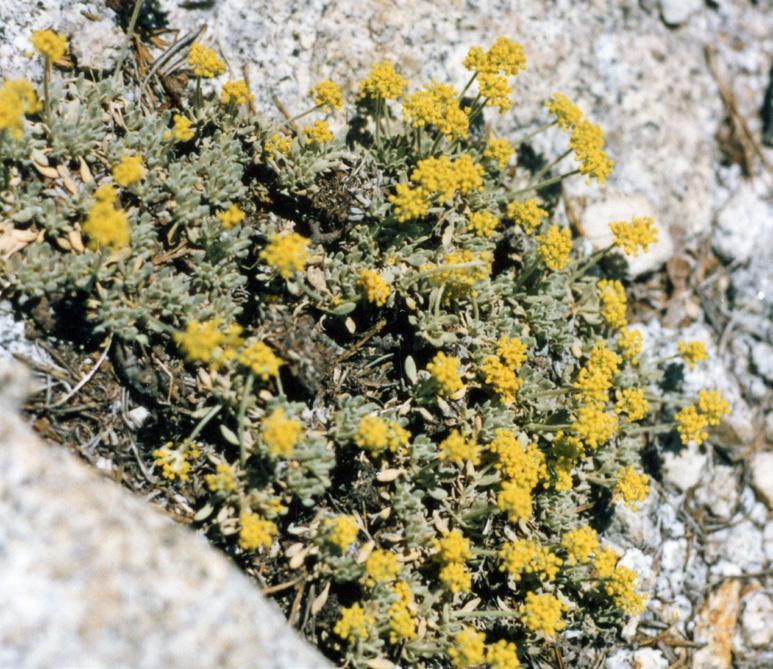

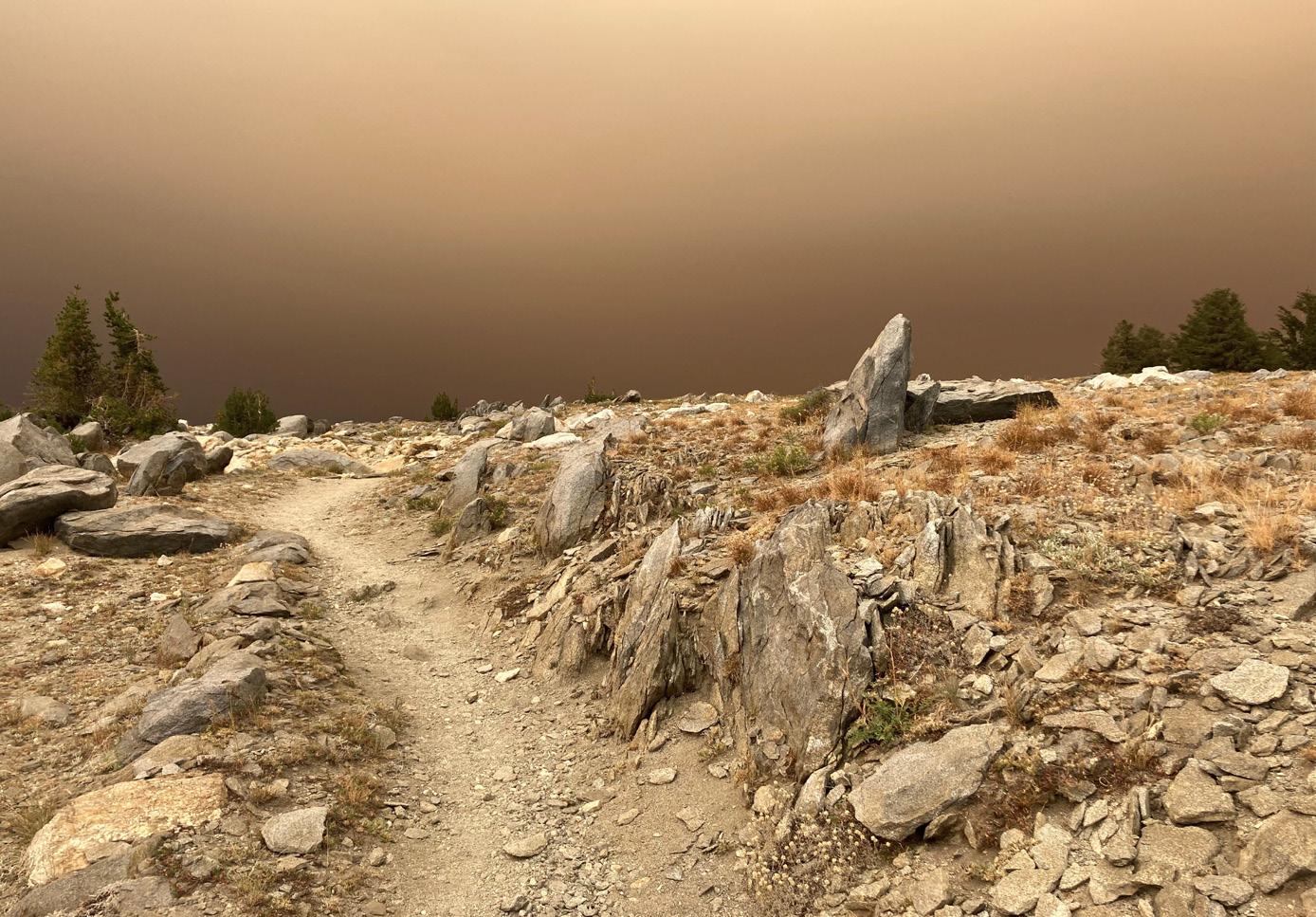
YOSEMITE CONSERVANCY
Magazine of Yosemite Conservancy, published twice a year.
MANAGING EDITORS
Gretchen Roecker & Megan Orpwood-Russell
CONTRIBUTING WRITERS
All content was written by the Yosemite Conservancy marketing team unless stated otherwise.
DESIGN
Eric Ball Design
STAFF :: San Francisco
Frank Dean, President & CEO
Jerry Edelbrock, Vice President & COO
Caitlin Allard, Senior Philanthropy Officer
Laura Garland, Director of Accounting
Kevin Gay, Chief Financial Officer
Marion Ingersoll, Chief Development Officer
Pongphat Kimpol, Data Services Analyst
Eryn Ligon, Data Services Manager
Isabelle Luebbers, Senior Annual Giving Director
Jessica Marx, Executive Affairs Manager
Megan Orpwood-Russell, Marketing Manager
Laurie Peterson, Senior Institutional Giving Officer
Xoe Riphenburg, Data Entry & Administrative Assistant
Gretchen Roecker, Senior Communications Manager
Elizabeth Sherer, Digital Media & Content Coordinator
Catelyn Spencer, Director of Planned Giving
Alison Walton, Events & Campaign Manager
Hannah Yee, Development & Donor Services Assistant
STAFF :: Yosemite
Adonia Ripple, Chief of Yosemite Operations
Jenny Anderson, Valley Complex Supervisor
Kristin Anderson, Art & Nature Center Program Manager
Greg Archer, Retail Accounting Coordinator
Carolyn Botell, Supervisor, Mariposa Grove Depot Bookstore
Nicole Brocchini, Museum Store Supervisor
Emily Brosk, Director of Volunteer Programs
Kylie Chappell, Director of Outdoor Programs
Katie Coit, Director of Retail Operations
Teresa Ellis, Sales & Information Assistant
Cory Goehring, Lead Naturalist
Schuyler Greenleaf, Chief of Projects
Ryan Kelly, Projects Manager
Cassie May, Program Coordinator – Data, Technology, Adventures
Simon McIntosh, Wilderness Programs Manager
Tina Moseley, Zero Landfill & Sustainability Coordinator
Madison Smith, Program Coordinator, Wholesale & Outreach
Lora Spielman, Art Center Coordinator
Shelly Stephens, Inventory Manager
STAFF :: Southern California
Julia Hejl, Philanthropy Officer, Southern CA
Spring.Summer 2021 :: Volume 12. Issue 01 ©2021
Federal Tax Identification No. 94-3058041
Ways to Give
THERE ARE MANY WAYS you and your organization can support the meaningful work of Yosemite Conservancy. We look forward to exploring these philanthropic opportunities with you.
CONTACT US
Visit yosemite.org
Email info@yosemite.org
Phone
415-434-1782
INDIVIDUAL GIVING
Chief Development Officer
Marion Ingersoll mingersoll@yosemite.org 415-434-8446 x324
Annual Giving & Sequoia Society Monthly Giving
Isabelle Luebbers iluebbers@yosemite.org 415-434-8446 x313 yosemite.org/monthlygift
Major Gifts — Northern California & National Caitlin Allard callard@yosemite.org 415-434-8446 x318
Major Gifts — Southern California
Julia Hejl jhejl@yosemite.org 323-217-4780
FOUNDATIONS & CORPORATIONS
Laurie Peterson lpeterson@yosemite.org 415-434-8446 x328
Yosemite Conservancy 101 Montgomery Street, Suite 1700 San Francisco, CA 94104
Fax 415-434-0745
PLANNED GIVING & BEQUESTS
Catelyn Spencer cspencer@yosemite.org 415-434-8446 x319 yosemite.org/legacy
HONOR & MEMORIAL GIFTS
Isabelle Luebbers iluebbers@yosemite.org 415-434-8446 x313 yosemite.org/celebrate
GIFTS OF STOCK
Eryn Ligon stock@yosemite.org 415-434-8446 x330 yosemite.org/stock
MATCHING GIFTS
Isabelle Luebbers iluebbers@yosemite.org 415-434-8446 x313
VOLUNTEER OPPORTUNITIES
Emily Brosk volunteers@yosemite.org 209-379-2317 yosemite.org/volunteer
Yosemite Conservancy
101 Montgomery Street, Suite 1700
San Francisco, CA 94104

Create Your Yosemite Legacy
Make a lasting investment in the future of Yosemite with a legacy gift to help protect this special place for generations to come.
Naming Yosemite Conservancy as a beneficiary in your will, trust or retirement account ensures the park remains well preserved and accessible. Your gift will become part of the Legacy Fund, which makes meaningful work possible far into the future.
To learn more about creating a legacy for Yosemite, please contact Catelyn Spencer at cspencer@yosemite.org or 415-434-8446 x319
yosemite.org/legacy
